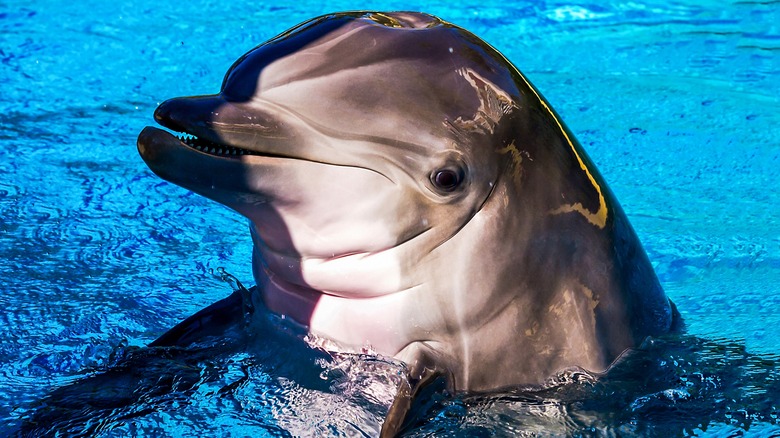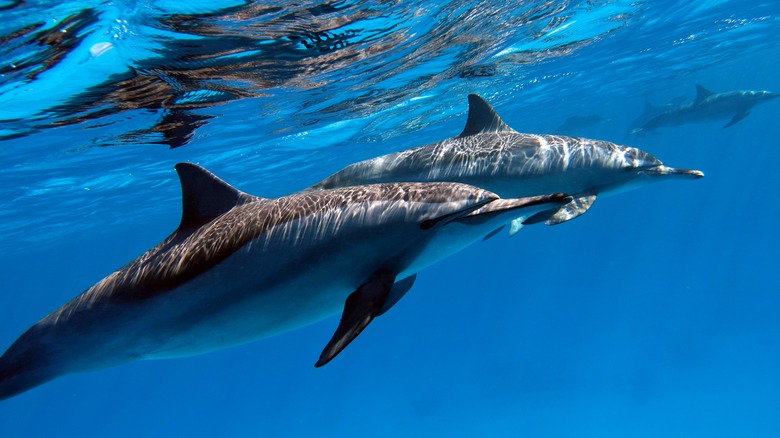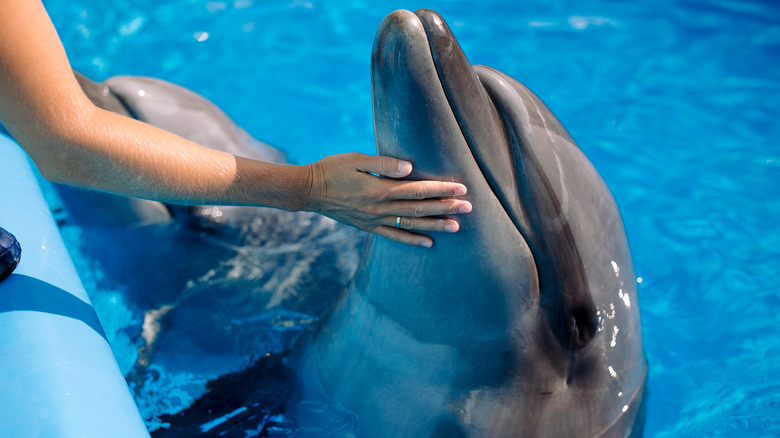The Unexpected Reason Dolphins Taste Each Other's Pee
Dolphins are truly remarkable animals. They may not be the largest or most magnificent of aquatic creatures — dolphin species don't tend to measure more than 10 feet long, according to Britannica – but they have many unique traits that set them apart and make them so beloved around the world.
Britannica goes on to state that their inquisitiveness, intelligence, and social behaviors make them a fascinating study, and New Zealand's University of Otago biologist Maddalena Fumagalli witnessed all of this first-hand. Investigating the effects tourists have on spinner dolphins in different regions of the Red Sea, Fumagalli reported to Science, "dolphins typically rest in tight schools; they swim very slowly together and coordinate their breathing." Disturbing the resting dolphins can be troublesome, but this behavior demonstrates that dolphin social groups can be tight-knit indeed.
Naturally, for close groups to form, trust between individuals is vital. To this end, everyone needs to be able to identify each other. How do dolphins do this? By tasting each other's pee, it seems.
How do dolphins know who's who? Urine for a surprise
Now, we humans enjoy a range of social relationships, and we're closer to some people than others. From a casual neighborhood acquaintance, we enjoy small talk with a partner or close relative who knows every aspect of our lives, each relationship we share is different. However intimate it may be, though, we don't tend to taste the urine of friends, family, co-workers, and other associates. Luckily, we can remember and identify each other without the need for such desperate measures, but it's a very helpful technique for dolphins.
In the 2022 study "Cross-modal perception of identity by sound and taste in bottlenose dolphins" (via Science), Jason N. Bruck et al detailed a unique experiment: The scientists "tested whether dolphins could use gustatory stimuli and found that they could distinguish between water and urine samples, as well as between urine from familiar and unfamiliar individuals."
The brilliant bottlenoses were reportedly far more interested in investigating the area where familiar animals' urine samples had been utilized, as though they were looking for a friend. In essence, it appears that this is exactly what they were doing.
There are less smelly methods of dolphin communication and identification
Dolphins do not have olfactory bulbs as Stephen F. Austin State University biologist Jason N. Bruck, who worked on the study, reported to Live Science. As such, the sense of taste must give them the information that smell perhaps can in other species. The curious creatures will swim through the urine of their fellows as they're peeing. They do this, Bruck concludes, "the way a dog sniffs a hydrant."
This is not, of course, the only way that dolphins communicate and learn about each other. Per the Whale and Dolphin Conservation (WDC), dolphin communication and navigation tends to center around that famous echolocation. Through the clicking sounds they emit, and the way sound waves return to them from the depths around them, they can detect things that are close by, and determine what they may be.
The WDC further states that whistling sounds the creatures make, distinct from their echolocation clicks, are for locating and communicating with their fellows. Dolphins, it seems, can also determine which of their fellows is making this sound, as they appear to be distinct to each animal (much as our voices are). From whistles to pee, though, these methods further demonstrate how very intelligent these unique animals are.


